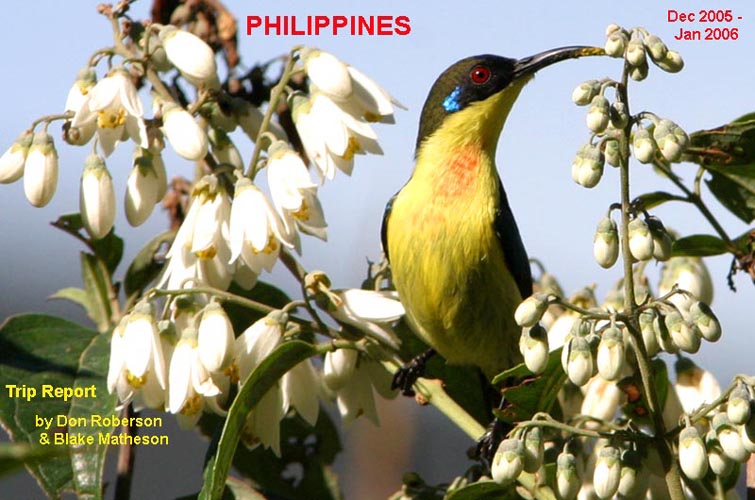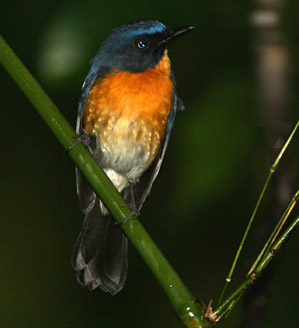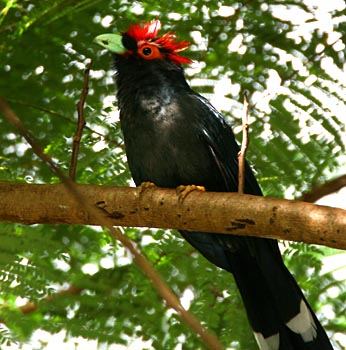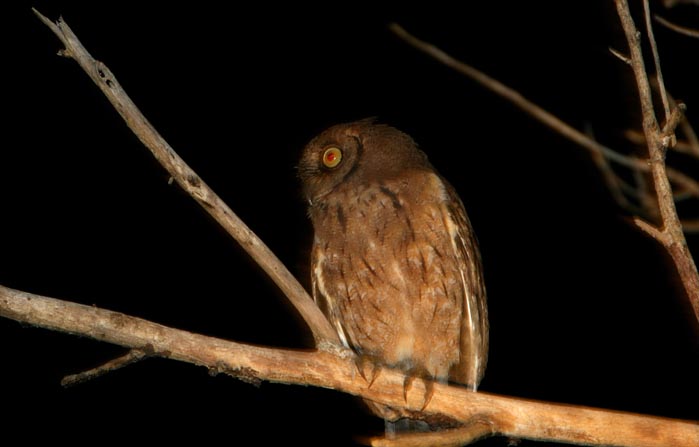

|
|
|
|
| 8 Dec (Mindoro): Don's notes for the day begin "In our cement
hut, they left the lights on all night. My tiny room was hot, sticky &
mossie-laden. Then they turned off the power as we got up. Go figure. Then
they brought in a captive Mindoro Bleeding-Heart. Thus was agonizing,
of course, but we were given permission to carry it into the forest for
release."
And so it was that we rescued a bleeding-heart, said to have been snared the previous day, and were able to release it back into the wild. Photos of the captive are above. A local guide carried it in a wicker basket until we found a good release spot — far off the trail and well in the forest — to let it go. We expected it to immediately fly away but instead it glided up to a branch and spent the next 20 minutes there, apparently regaining its orientation. We had also been a little concerned about its physical condition, as it had a superficial leg injury, but the pigeon walked up and down the branch easily, preened itself, and seemed in good shape. Finally, at its own choosing, it flew straight downhill and disappeared. It flew well and appeared to be okay. A photo of the release (JK lifts the lid on the basket as TF looks on) and of the bird itself in the wild are below.
|
|||
 9
Dec (Mindoro): Much of the rest of the morning was spent hiking up
steep, muddy trails to get deeper into the forest. As we crossed a small
rise several miles up the hill, our lead guide flushed another Mindoro
Bleeding-Heart from the trail, and it flew low and fast downhill. None
of us saw it, although we spread out and searched the downslope hillside
(not easily due to outcrops of sharp kaarst and many ravines) for some
time. We did get a good view of Black-hooded Coucal on our way down.
An occasional Mangrove Blue-Flycatcher in the forest (right; photo
© Blake Matheson) further brightened this hike. Some of the
group also had a Pechora Pipit along a little rivulet in the forest. 9
Dec (Mindoro): Much of the rest of the morning was spent hiking up
steep, muddy trails to get deeper into the forest. As we crossed a small
rise several miles up the hill, our lead guide flushed another Mindoro
Bleeding-Heart from the trail, and it flew low and fast downhill. None
of us saw it, although we spread out and searched the downslope hillside
(not easily due to outcrops of sharp kaarst and many ravines) for some
time. We did get a good view of Black-hooded Coucal on our way down.
An occasional Mangrove Blue-Flycatcher in the forest (right; photo
© Blake Matheson) further brightened this hike. Some of the
group also had a Pechora Pipit along a little rivulet in the forest.
At mid-day, Don swan with some of the locals in the nearby river, and we all packed up for the drive back to San Jose to stay overnight at a local hotel. |
|||
 10
Dec (Luzon): Up early for for a 7 a.m. flight back to Manila. This
is the day Volker Schmidt was scheduled to meet up with us, but his plane
was delayed and we didn't actually connect until we were in a pouring rainstorm
in late afternoon. 10
Dec (Luzon): Up early for for a 7 a.m. flight back to Manila. This
is the day Volker Schmidt was scheduled to meet up with us, but his plane
was delayed and we didn't actually connect until we were in a pouring rainstorm
in late afternoon.
It would rain off and on all day. We traveled the 2+ hours by van to Mt. Makiling and checked into our lodging at the "Trees" accommodations. These are rooms set up for visiting scientists to the adjacent research campus. From here a wide trail continues upward into the forest on Mt. Makiling itself. Philippine Falconets and then a party of Red-crested Malkoha (left; photo © Blake Matheson) were treats just outside the lodging. An Indigo-banded Kingfisher was along the rushing stream on the campus below. We spent the last couple hours of daylight scoping down a soggy farm track, waiting for buttonquail to cross. Each of us took turns on the two scopes [TF had one, and JK had brought another]. Those on the scope at the time got the best views of whatever crossed the path down in the shady bit. We would do this again the next afternoon. Between the two visits we had multiple sightings of Spotted & Barred Buttonquails, and a party of Plain Bush-hen. At dusk, several Great Eared Nightjar appeared. |
|||
|
Forested Mt. Makiling (above) rises
above the town & campus that lie beneath;
(below) Rain pelts down on a Naked-faced Spiderhunter. Both © D. Roberson |
|||
In the afternoon the rest of the group catches up on Lowland White-eye on campus, and the Indigo-banded Kingfishers are seen again. Plus we do the buttonquail path again before driving back to Manila to overnight before our flight to Palawan. |
|||
| 12 Dec (Palawan): Up at 5 a.m. to make the 8 a.m. flight to
Puerto Princesa. The domestic airport is jammed with passengers — the most
'third-world' experience we'll have at any Philippine airport. As we descend
toward Palawan, we find we are in a fierce rainstorm. The captain says
he'll give one try to land and, if we can't, we're headed back to Manila.
Luck is with us: he does make the landing and we are not delayed! But the
storm is pelting down and most of this day will be washed out.
We meet our local contact — the energetic and engaging Arnel Mallari — and head for the shoreline at nearby Garceliano Beach. Here there are mangroves backing a rocky, volcanic shoreline with small stretches of sandy beach. We view a huge storm out in the channel to the east and do some seawatching (below). The inclement weather has pushed hundreds of terns near to shore: both Bridled & Sooty Terns are identified, although so many are so distant that we can't get a handle on relative proportions. birding in the rain on Palawan's shoreline:
(L to R), Arnel, Volker, Anne, Jon, Blake, Tim
|
|||
Of course the main reason to visit Garceliano Beach is not for sea-watching or to pad one's Philippine list with migrant shorebirds (although we do both), but to see the endangered Chinese Egret. The tide is receding during our visit, and we find 3 Chinese Egrets among the more numerous Little Egrets. This digiscoped shot (left) has 3 Little Egrets next to the somewhat larger Chinese Egret. We then drive in the rain to Sabang on the northwest coast of Palawan, and to our accommodations at the Last Frontier Resort. The resort is very nice, the food exceptional, and the beer cold. But pouring rain precludes any significant birding for the rest of the day. We hope our entire Palawan component won't be washed away. It rains all night. |
|||
Good luck was with us upon landing. We were the first tourists present, and in the picnic ground the male Palawan Peacock-Pheasant — its been a stakeout here for a couple years — was almost immediately calling hereby. We waiting patiently and the pheasant strolled out into the open, showing its glowing iridescent plumage and spectacular tail and head plume. He seemed mostly unconcerned with us and actually seemed to follow us around for awhile. From time to time he would stop to spread his tail low and give a series of calls. Eventually we found what was triggering these displays: a female had arrived! She was very shy, compared to the male, but he chased her around a bit. It had been thought that this was an unmated male [e.g., in Ben King's brochure promoted the Kingbird Tour to the Philippines he talks of this male as the "habituated bird that is apparently not breeding and when he dies, it's back to regularly missing this species altogether"]. Well, its seems that he might breed after all. Blake got a series of superb photos, and the experience was one of the high points of the trip. St. Pauls Subterranean Park is named for its underground river: the park offers canoe rides for several kms inside a cave. A small floodlight powered by a car battery provides the light. Don opted to take the boat ride; since he was the only taker he got a personally guided private tour of the cave. The cave itself had impressive stalagmites and stalagmites, and some nests of swiftlets (not currently in use), but Don was much more impressed with the roosting bats. There were thousands of bats roosting in the cave. There are said to be at least 10 species here: Don sorted out at least 7 types by size and color. Many were very tiny bats hanging upside down from small crevices, or 'carpeting' the cave's roof in places. While Don was on the boat, the rest of the group were chasing down and ticking birds Don had seen before (e.g., Palawan Blue-Flycatcher) and one he had not (Blue-headed Racquet-tail). We all enjoyed fine views of Yellow-throated Leafbird and non-endemic Chestnut-breasted Malkoha, Common Flameback, Asian Drongo-Cuckoo, Bar-bellied Cuckoo-Shrike, and Asian Fairy-Bluebird. |
|||
|
|||
|
Getting off the beach in the outriggers proved quite difficult. The six of us were quite a boatload and the surf had become more treacherous. By the time we had made it to sea, we all were drenched with salt-water (right: Don, Arnel, & Tim stand on the Sabang dock after the soaking wet boat ride and landing; photo © Anne & Jon King). Back on the mainland, and after a great lunch, we birded patches of forest along the road through the interior, adding endemics Blue Paradise-Flycatcher, Palawan and Pygmy Flowerpeckers. We waited until dusk around the vicinity of 'Lion's Cave' for owls and frogmouths. Arnel had specific spots staked out, and (with tapes) we were promptly treated to superb views of Palawan Scops-Owl (below left), a small scops-owl with a very deep, gruff call, and Javan Frogmouth (below right; photo © Blake Matheson). |
|||
|
|||
| 14 Dec (Palawan): Up at 4:30 for a hike to "Central Park
Station" in St. Pauls Park. This involves walking to Sabang and then up
the beach (finding Malay Plover in route) and then climbing a steep
trail and stairway over a limestone ridge to the next river valley north.
Here Tim takes us on an obscure trail back into the swamp, hoping for Hooded
Pitta and Falcated Ground-Babbler. We strike out and come back to the coast
where we find White-vented Shama, Sulphur-bellied Bulbul,
and a pair of Tabon Scrubfowl. Later we try the trail again — scrambling
over fallen trees and crossing the creek many times — until we come to
the base of a steep hill. Here we try the ground-babbler tape again (no
luck) but suddenly hear Palawan Hornbills in the forest. Our view
is blocked so we scramble up the steep, muddy hill in hopes of seeing the
hornbills, and become distracted by a party of Palawan Tit as we
do so. We never do glimpse the hornbills — this will be perhaps the worst
miss on the trip ('heard-only' birds don't count on any of our lists).
It is now near mid-day and hot, muggy, and muddy. Since we are already halfway up this incredible hill, and Tim says it does lead back to Sabang, we continue on, stumblin' and a-bumblin' across roots and thickets as we dodge fallen trees (this 'Jungle Trail' is not much maintained). At the crest of the hill a Falcated Ground-Babbler is calling well down the next slope, but Tim is tapes it in for nice views. By the time we negotiate the rest of the trail back to the coastal mangroves, some of us are simply wiped out. In the afternoon we drive back to Puerto Princesa, stopping enroute at good viewing spots in hopes of seeing hornbills, but none ever come. This species is clearly in decline. We did pick up Rufous-tailed Tailorbird before dusk falls. Its a long 2.5 hour ride in the dark to our hotel. |
|||
| 15 Dec (Palawan): Up at 4 a.m. and on the road to Iwahig penal
colony to bird along the famed Balsahan trail. Tim had advised there would
be river crossings, so Don wore green wellies. The rest just took off shoes
and waded (photo above; Anne & Jon King wade the Iwahig River).
It was raining early but let up soon enough. Birding slowly and using the
tape, we gradually pick up the specialties here: endemic
Melodious
&
Ashy-headed Babblers; local race of Hooded Pitta finally seen;
a party of
Hill Mynas.
On our way south towards the resort town of Narra, we engage in 'paddy bashing,' to wit, stopping and birding rice paddy after rice paddy in hopes of waders and the like. We do see lots of Wood Sandpipers and a few Long-toed Stints. Then its a 2-hour drive to La Vista Resort in Narra. The wind has picked up and the ocean is very choppy, but this afternoon we have scheduled our boat ride to La Rasa Island. The six of us are packed into another outrigger. This time it's not the breakers but the waves offshore that finally drench us again (fortunately the high-quality binoculars are essentially waterproof). Our goal is the north side of La Rasa — a tiny offshore islet with bits of forest and stretches of mangroves that now hosts the world's largest concentration of the critically endangered Philippine (Red-vented) Cockatoo. Back in 1990, Don had seen a pair on the Balsahan trail. Today, they are almost never seen on the mainland. There is a dusk roost, though, at a cove on the north end of Rasa I., and so we slowly pound through the waves to get there. Because of the high seas, we dare not drift too close to shore so our viewpoint is a bit farther offshore than ideal. We cut the engine and wait 50 minutes for the cockatoos to begin arriving. They come all at a rush just near dusk — perhaps 35-40 in all — and at one point are all flushed by a passing Great-billed Heron. Still, the views are distant and marginal. |
|||
 |
|||
|
|||
|
|||
|
|||
| PHOTOS: All photos on this page are © 2006 Don Roberson,
except those © Blake Matheson, or © Anne & Jon King, and
so indicated; all rights reserved. Many other shots from this trip are
scattered about this web site.
Literature cited: Brooks, T., G. Dutson, L. Gabutero, and R. Timmins. 1995. Siburan — key area for birds on Mindoro. Oriental Bird Club Bulletin 21: 28-33.TOP TO LIST OF BIRD FAMILIES OF THE WORLD |